Similar presentations:
Programming on Python. Lecture 7
1.
Programming on PythonLecture 7
Regular expression
Complied by
Aizhan Altaibek
2.
Intro to Python for Data ScienceRegular Expression
2
3.
34.
WHAT IS A REGULAR EXPRESSION?A Regular Expression (RegEx) is a sequence of characters that defines
a search pattern.
For example,
^a...s$
The above code defines a RegEx pattern.
The pattern is: any five letter string starting with a and ending with s.
4
5.
A pattern defined using RegEx can be used to match against a string.Expression
^a...s$
String
Matched?
abs
No match
alias
Match
abyss
Match
Alias
No match
An abacus
No match
5
6.
Python has a module named re to work with RegEx. Here's an example:import re
pattern = '^a...s$’
test_string = 'abyss’
result = re.match(pattern, test_string)
if result:
print("Search successful.")
else: print("Search unsuccessful.")
Here, we used re.match() function to search pattern within the test_string.
The method returns a match object if the search is successful. If not, it returns None.
6
7.
THERE ARE OTHER SEVERAL FUNCTIONS DEFINED INTHE RE MODULE TO WORK WITH REGEX. BEFORE WE EXPLORE
THAT, LET'S LEARN ABOUT REGULAR EXPRESSIONS.
7
8.
SPECIFY PATTERN USING REGEXTo specify regular expressions, metacharacters are used.
In the previous example, ^ and $ are metacharacters.
8
9.
METACHARACTERSMETACHARACTERS ARE CHARACTERS THAT ARE
INTERPRETED IN A SPECIAL WAY BY A REGEX ENGINE. HERE'S
A LIST OF METACHARACTERS:
[] . ^ $ * + ? {} () \ |
9
10.
METACHARACTERS[] - Square brackets
Square brackets specifies a set of characters you wish to match.
Expression
[abc]
String
Matched?
a
1 match
ac
2 matches
Hey Jude
No match
abc de ca
5 matches
Here, [abc] will match if the
string you are trying to match
contains any of the a, b or c.
10
11.
METACHARACTERSYou can also specify a range of characters using - inside square brackets.
•[a-e] is the same as [abcde].
•[1-4] is the same as [1234].
•[0-39] is the same as [01239].
You can complement (invert) the character set by using caret ^ symbol at
the start of a square-bracket.
•[^abc] means any character except a or b or c.
•[^0-9] means any non-digit character.
11
12.
METACHARACTERS. - Period
A period matches any single character (except newline '\n').
Expression
..
String
Matched?
a
No match
ac
1 match
acd
1 match
acde
2 matches (contains 4
characters)
12
13.
METACHARACTERS^ - Caret
The caret symbol ^ is used to check if a string starts with a certain character.
Expression
^a
^ab
String
a
abc
bac
abc
Matched?
1 match
1 match
No match
1 match
acb
No match (starts with a but
not followed by b)
13
14.
METACHARACTERS$ - Dollar
The dollar symbol $ is used to check if a string ends with a certain character.
Expression
a$
String
Matched?
a
1 match
formula
1 match
cab
No match
14
15.
METACHARACTERS* - Star
The star symbol * matches zero or more occurrences of the pattern left to it.
Expression
ma*n
String
Matched?
mn
1 match
man
1 match
maaan
1 match
main
No match (a is not followed by n)
woman
1 match
15
16.
METACHARACTERS+ - Plus
The plus symbol + matches one or more occurrences of the pattern left to it
Expression
ma+n
String
Matched?
mn
No match (no a character)
man
maaan
1 match
1 match
main
No match (a is not followed by n)
woman
1 match
16
17.
METACHARACTERS? - Question Mark
The question mark symbol ? matches zero or one occurrence of the pattern left to it.
Expression
String
mn
man
Matched?
1 match
1 match
ma?n
maaan
No match (more than one a character)
main
No match (a is not followed by n)
woman
1 match
17
18.
METACHARACTERS{} - Braces
Consider this code: {n,m}.
This means at least n, and at most m repetitions of the pattern left to it.
Expression
String
abc dat
abc daat
Matched?
No match
1 match (at daat)
a{2,3}
aabc daaat
2 matches (at aabc and daaat)
aabc daaaat
2 matches (at aabc and daaaat)
18
19.
METACHARACTERSLet's try one more example. This RegEx [0-9]{2, 4} matches at least 2 digits but not more than 4 dig
Expression
[0-9]{2,4}
String
Matched?
ab123csde
1 match (match at
ab123csde)
12 and 345673
3 matches (12, 3456, 73)
1 and 2
No match
19
20.
METACHARACTERS| - Alternation
Vertical bar | is used for alternation (or operator).
Expression
a|b
String
Matched?
cde
No match
ade
1 match (match at ade)
acdbea
3 matches (at acdbea)
Here, a|b match any string that contains either a or b
20
21.
METACHARACTERS() - Group
Parentheses () is used to group sub-patterns. For example, (a|b|c)xz match any string tha
matches either a or b or c followed by xz
Expression
(a|b|c)xz
String
Matched?
ab xz
No match
abxz
1 match (match at abxz)
axz cabxz
2 matches (at axz cabxz)
21
22.
METACHARACTERS\ - Backslash
Backlash \ is used to escape various characters including all
metacharacters.
For example,
\$a match if a string contains $ followed by a. Here, $ is not interpreted by a
RegEx engine in a special way.
If you are unsure if a character has special meaning or not, you can put \ in
front of it. This makes sure the character is not treated in a special way.
22
23.
SPECIAL SEQUENCESSpecial sequences make commonly used patterns easier to write. Here's a
list of special sequences:
\A - Matches if the specified characters are at the start of a string.
Expression
\Athe
String
Matched?
the sun
Match
In the sun
No match
23
24.
SPECIAL SEQUENCES\b - Matches if the specified characters are at the beginning or end of a word.
Expression
\bfoo
foo\b
String
Matched?
football
Match
a football
Match
afootball
No match
the foo
Match
the afoo test
Match
the afootest
No match
24
25.
SPECIAL SEQUENCES\B - Opposite of \b. Matches if the specified characters are not at the beginning or end of a word.
Expression
\Bfoo
foo\B
String
football
a football
afootball
the foo
the afoo test
the afootest
Matched?
No match
No match
Match
No match
No match
Match
25
26.
SPECIAL SEQUENCES\d - Matches any decimal digit. Equivalent to [0-9]
Expression
\d
String
Matched?
12abc3
3 matches (at 12abc3)
Python
No match
\D - Matches any non-decimal digit. Equivalent to [^0-9]
Expression
\D
String
Matched?
1ab34"50
3 matches (at 1ab34"50)
1345
No match
26
27.
SPECIAL SEQUENCES\s - Matches where a string contains any whitespace character. Equivalent to [ \t\n\r\f\v].
Expression
\s
String
Matched?
Python RegEx
1 match
PythonRegEx
No match
\S - Matches where a string contains any non-whitespace character. Equivalent to [^ \t\n\r\f\v].
Expression
\S
String
Matched?
ab
2 matches (at a b)
No match
27
28.
SPECIAL SEQUENCES\w - Matches any alphanumeric character (digits and alphabets). Equivalent to [a-zA-Z0-9_].
By the way, underscore _ is also considered an alphanumeric character.
Expression
\w
String
Matched?
12&": ;c
3 matches (at 12&": ;c)
%"> !
No match
\W - Matches any non-alphanumeric character. Equivalent to [^a-zA-Z0-9_]
Expression
\W
String
Matched?
1a2%c
1 match (at 1a2%c)
Python
No match
28
29.
SPECIAL SEQUENCES\Z - Matches if the specified characters are at the end of a string.
Expression
Python\Z
String
Matched?
I like Python
1 match
I like Python Programming
No match
Python is fun.
No match
29
30.
SPECIAL SEQUENCESTip: To build and test regular expressions, you can use RegEx
tester tools such as regex101.com. This tool not only helps you in
creating regular expressions, but it also helps you learn it.
Now we understand the basics of RegEx, let’s learn how to use
RegEx in Python code.
30
31.
PYTHON REGEXPython has a module named re to work with regular expressions.
To use it, we need to import the module.
import re
The module defines several functions and constants to work with RegEx.
31
32.
PYTHON REGEXre.findall()
The re.findall() method returns a list of strings containing all matches.
Example 1: re.findall()
# Program to extract numbers from a string
import re
string = 'hello 12 hi 89. Howdy 34’
pattern = '\d+’
result = re.findall(pattern, string)
print(result) # Output: ['12', '89', '34’]
If the pattern is not found, re.findall() returns an empty list.
32
33.
PYTHON REGEXre.split()
The re.split method splits the string where there is a match and returns a list of strings
where the splits have occurred.
Example 2: re.split()
import re
string = 'Twelve:12 Eighty nine:89.’
pattern = '\d+’
result = re.split(pattern, string)
print(result)
# Output: ['Twelve:', ' Eighty nine:', '.’]
If the pattern is not found, re.split() returns a list containing the original string.
33
34.
PYTHON REGEXYou can pass maxsplit argument to the re.split() method. It's the maximum number of splits that will
occur.
import re
string = 'Twelve:12 Eighty nine:89 Nine:9.’
pattern = '\d+' # maxsplit = 1 # split only at the first occurrence
result = re.split(pattern, string, 1)
print(result)
# Output: ['Twelve:', ' Eighty nine:89 Nine:9.’]
By the way, the default value of maxsplit is 0; meaning all possible splits.
34
35.
PYTHON REGEXre.sub()
The syntax of re.sub() is:
re.sub(pattern, replace, string)
The method returns a string where matched occurrences are replaced with
the content of replace variable.
35
36.
PYTHON REGEXExample 3: re.sub()
# Program to remove all whitespaces
import re
# multiline string
string = 'abc 12\ de 23 \n f45 6’
# matches all whitespace characters
pattern = '\s+’
# empty string
replace = ‘’
new_string = re.sub(pattern, replace, string)
print(new_string)
# Output: abc12de23f456
If the pattern is not found, re.sub() returns the original string.
36
37.
PYTHON REGEXYou can pass count as a fourth parameter to the re.sub() method.
If omitted, it results to 0. This will replace all occurrences.
import re
# multiline string
string = 'abc 12\ de 23 \n f45 6’
# matches all whitespace characters
pattern = '\s+’
replace = ‘’
new_string = re.sub(pattern, replace, string, 1)
print(new_string)
# Output:
# abc12\ de 23
# f45 6
37
38.
PYTHON REGEXre.subn()
The re.subn() is similar to re.sub() expect it returns a tuple of 2 items containing the
new string and the number of substitutions made.
Example 4: re.subn()
# Program to remove all whitespaces
import re
# multiline string
string = 'abc 12\ de 23 \n f45 6’
# matches all whitespace characters
pattern = '\s+’
# empty string
replace = ‘’
new_string = re.subn(pattern, replace, string)
print(new_string)
# Output: ('abc12de23f456', 4)
38
39.
PYTHON REGEXre.search()
The re.search() method takes two arguments: a pattern and a string.
The method looks for the first location where the RegEx pattern produces a match
with the string.
If the search is successful, re.search() returns a match object; if not, it returns None.
match = re.search(pattern, str)
39
40.
PYTHON REGEXExample 5: re.search()
import re
string = "Python is fun"
# check if 'Python' is at the beginning
match = re.search('\APython', string)
if match:
print("pattern found inside the string")
else:
print("pattern not found")
# Output: pattern found inside the string
Here, match contains a match object.
40
41.
MATCH OBJECTYou can get methods and attributes of a match object using dir() function.
Some of the commonly used methods and attributes of match objects are:
match.group()
The group() method returns the part of the string where there is a match.
Example 6: Match object
Here, match variable
import re string = '39801 356, 2102 1111’
contains a match
# Three digit number followed by space followed by two digit number
object.
pattern = '(\d{3}) (\d{2})’
# match variable contains a Match object.
match = re.search(pattern, string)
if match:
print(match.group())
else: print("pattern not found")
# Output: 801 35
41
42.
MATCH OBJECTmatch.start(), match.end() and match.span()
The start() function returns the index of the start of the matched substring.
Similarly, end() returns the end index of the matched substring.
>>> match.start()
2
>>> match.end()
8
The span() function returns a tuple containing start and end index of the matched part.
>>> match.span()
(2, 8)
42
43.
MATCH OBJECTmatch.re and match.string
The re attribute of a matched object returns a regular expression object.
Similarly, string attribute returns the passed string.
>>> match.re
re.compile('(\\d{3}) (\\d{2})’)
>>> match.string
'39801 356, 2102 1111'
43
44.
USING R PREFIX BEFORE REGEXWhen r or R prefix is used before a regular expression, it means raw string. For example, '\n' is a new
line whereas r'\n' means two characters: a backslash \ followed by n.
Backlash \ is used to escape various characters including all metacharacters. However, using r prefix
makes \ treat as a normal character.
Example 7: Raw string using r prefix
import re
string = '\n and \r are escape sequences.’
result = re.findall(r'[\n\r]', string)
print(result)
# Output: ['\n', '\r']
44






















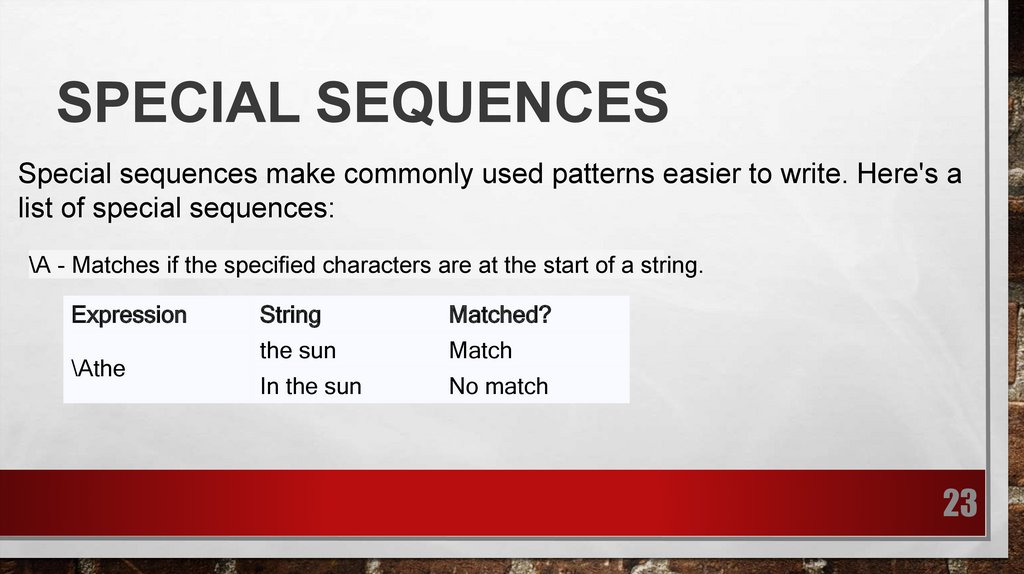
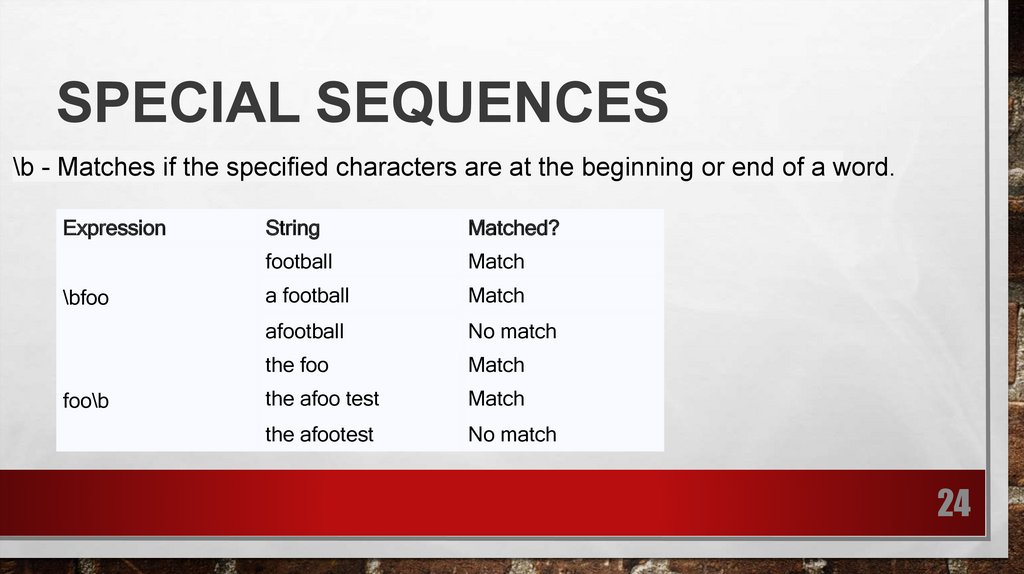




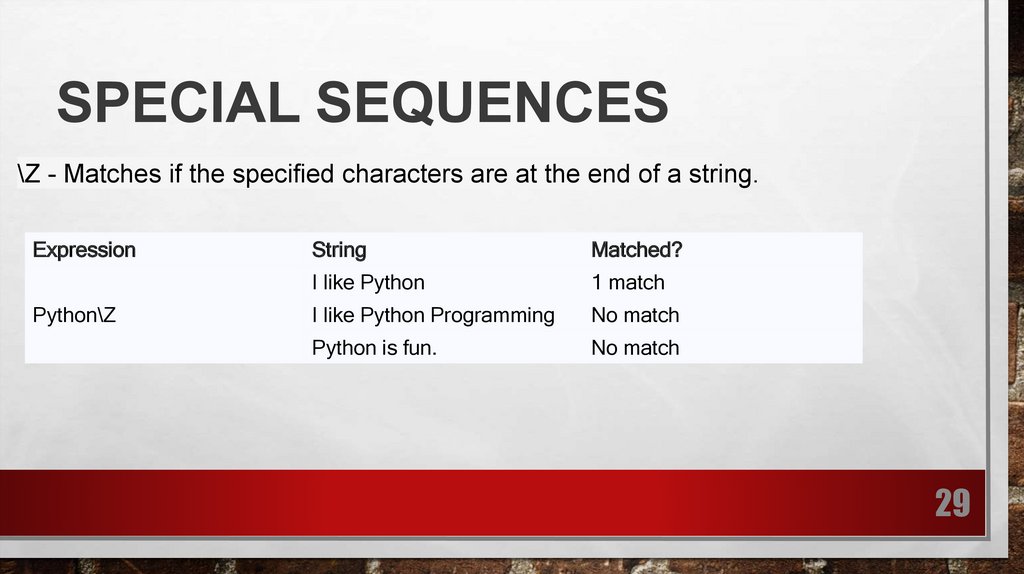
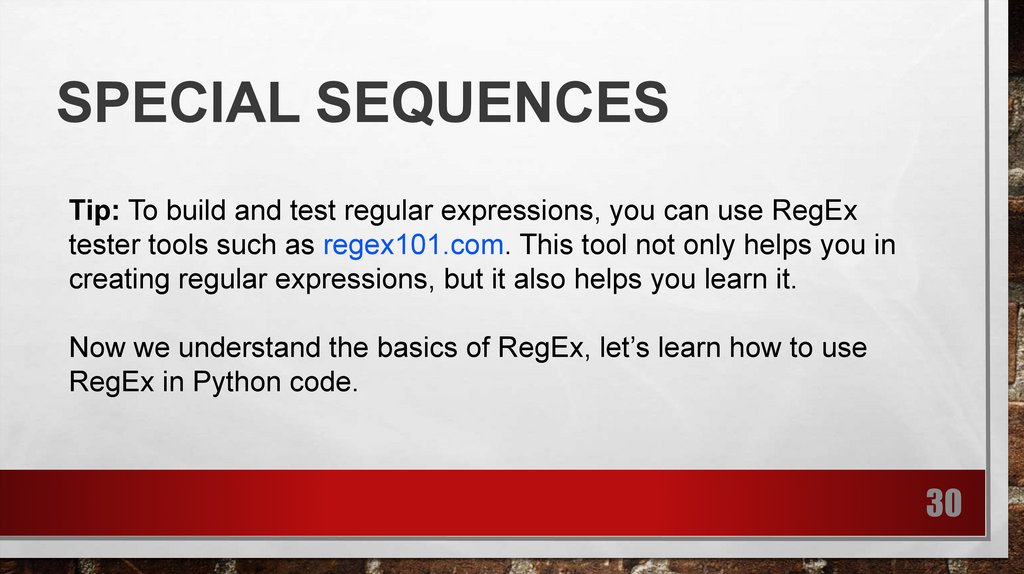
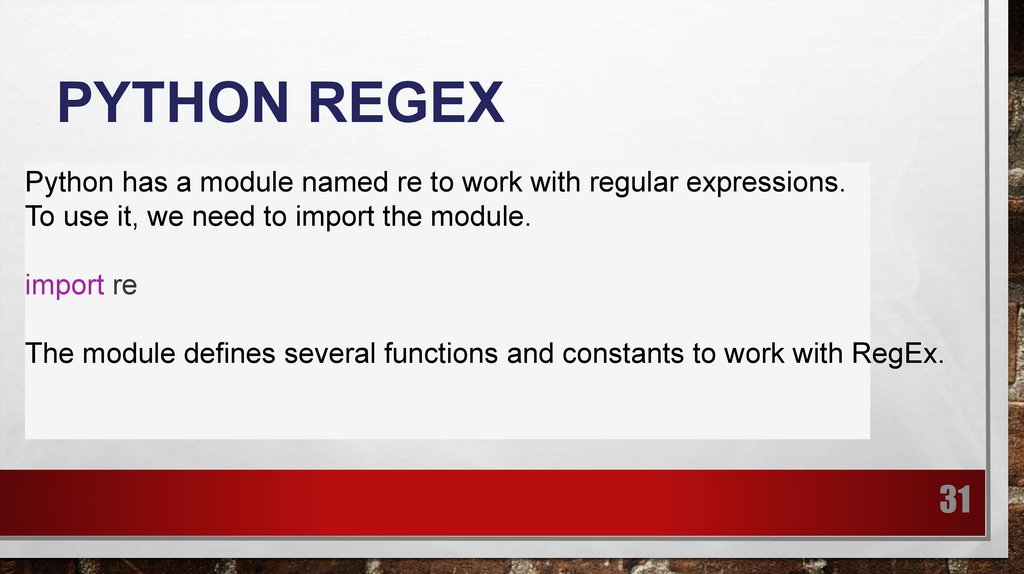







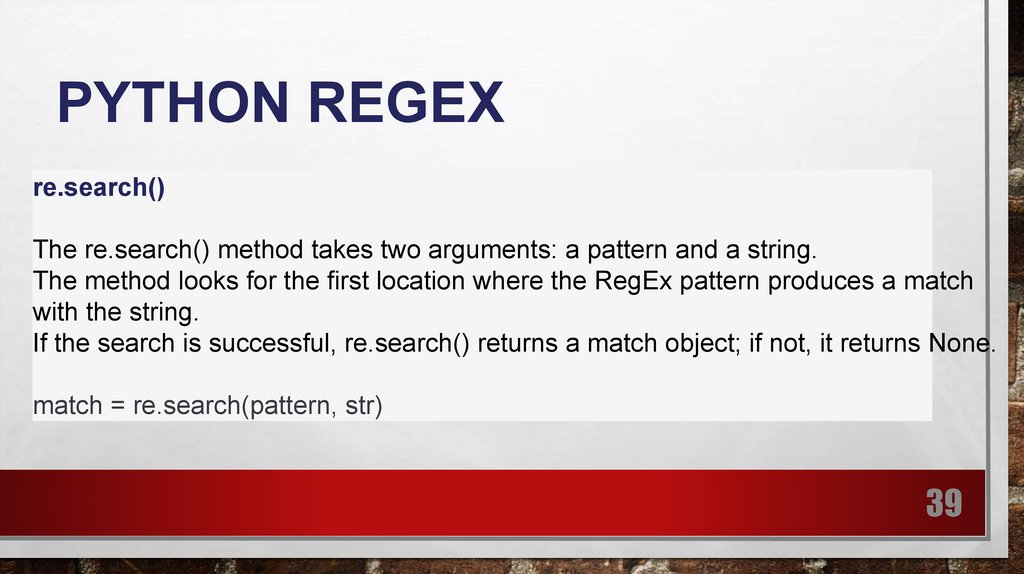






 software
software








